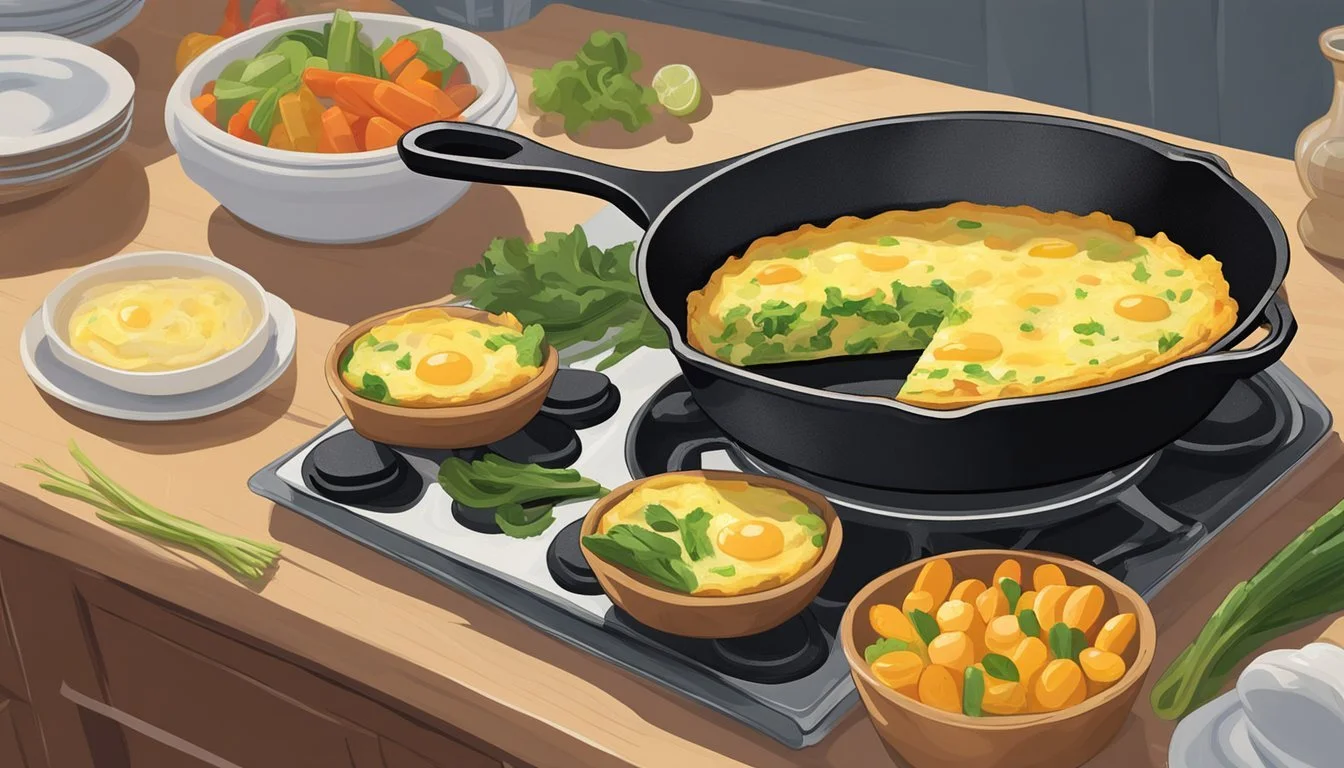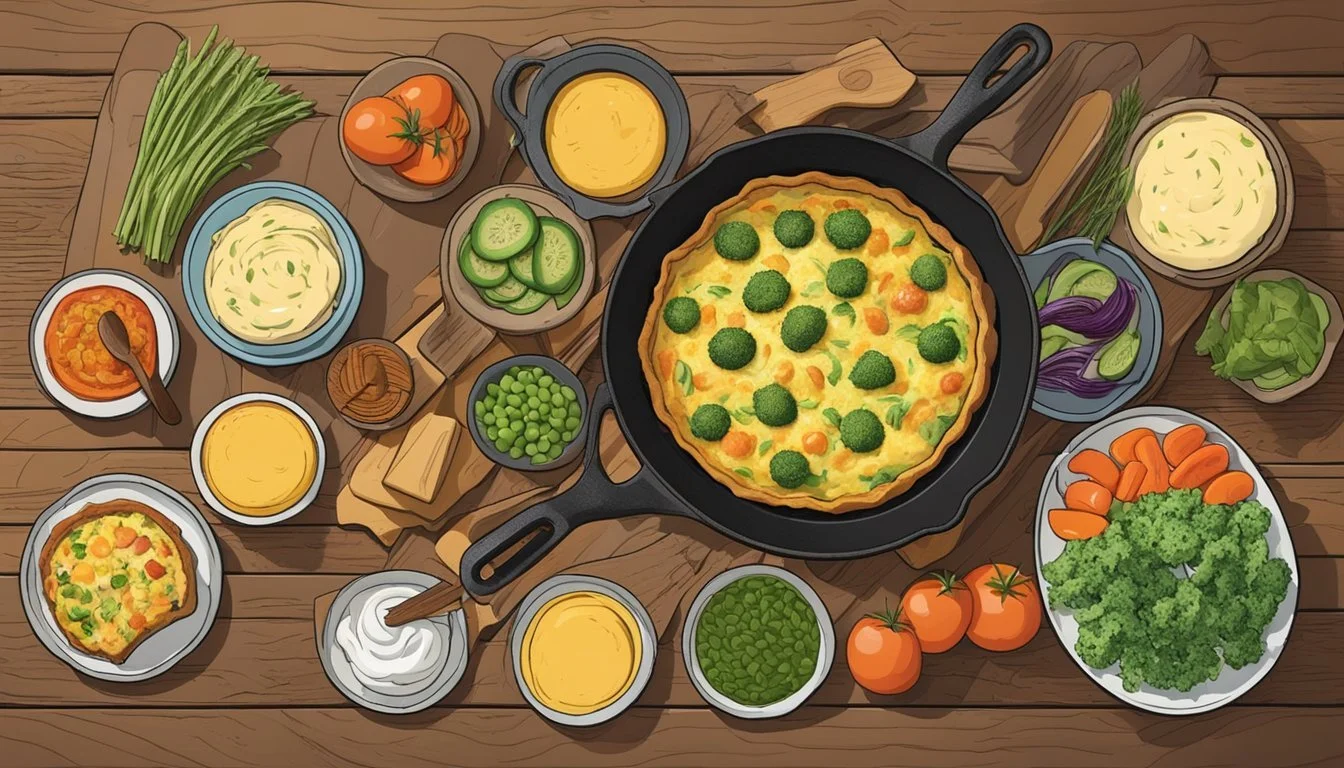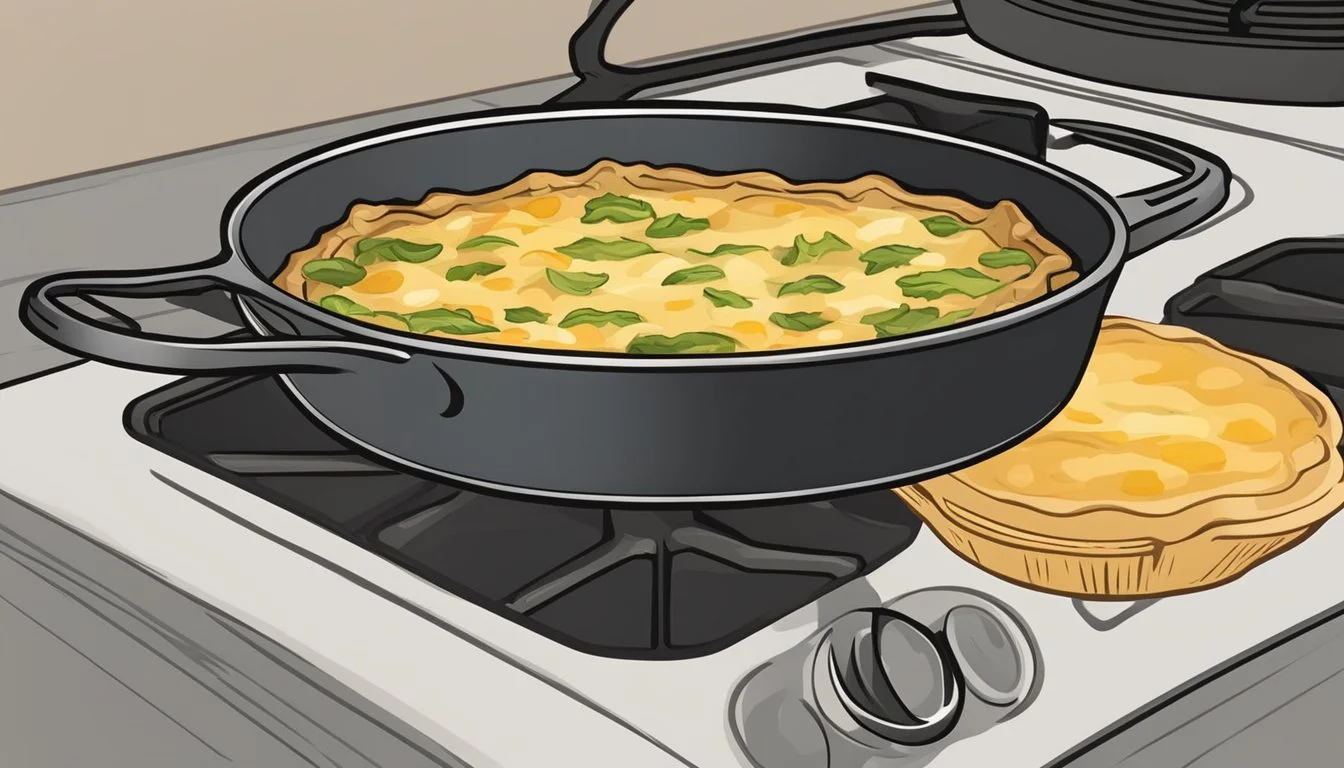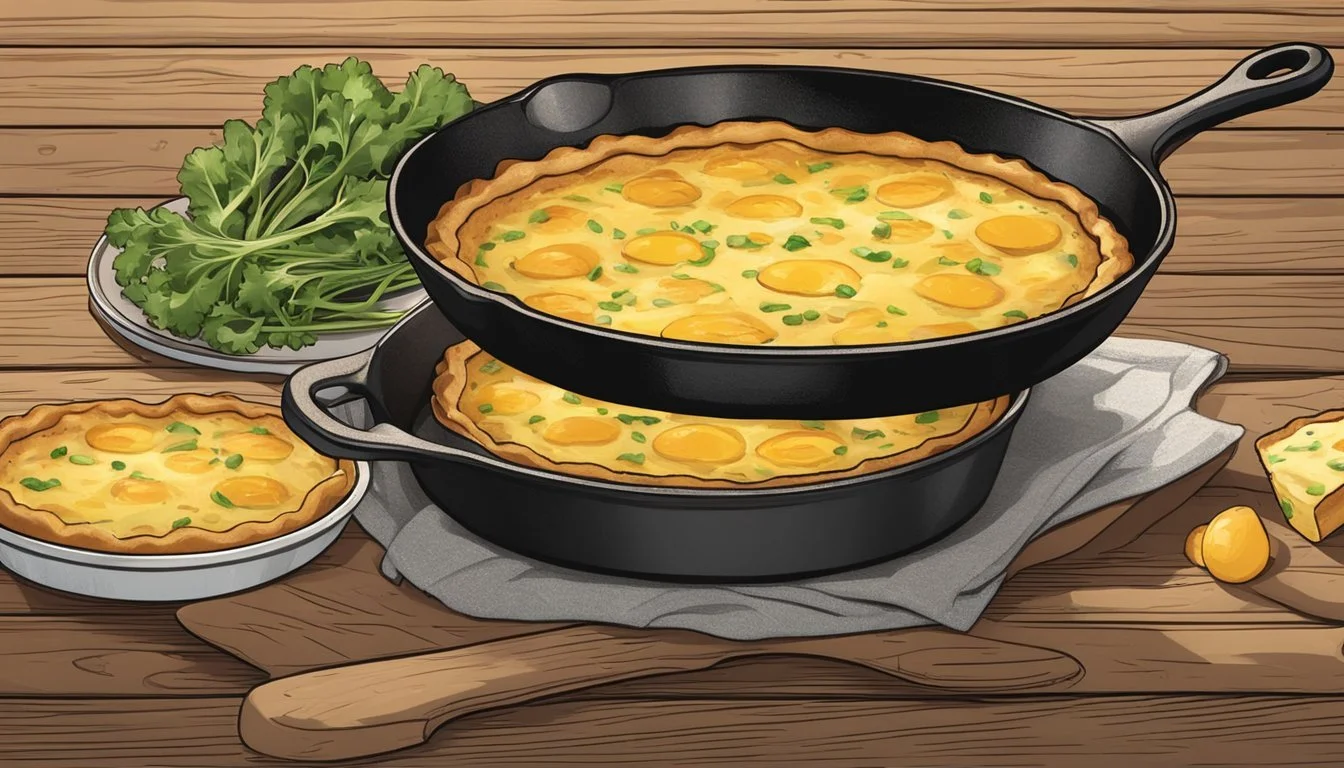The Cast Iron Skillet Quiche
Discover the Joy of Crustless Baking
The cast iron skillet is a versatile kitchen tool, often hailed for its heat retention and even cooking. These properties make it an excellent choice for preparing a variety of dishes, including the crustless quiche. A crustless quiche offers a lighter, yet still satisfying, alternative to its traditional, crust-laden counterpart. This version is well-suited for those seeking a healthy meal that does not sacrifice flavor for nutritional value.
Preparing a crustless quiche in a cast iron skillet involves cooking a mixture of eggs and dairy—typically milk or cream—combined with a variety of fillings such as vegetables, meats, and cheeses. The ingredients are whisked together and poured into the preheated skillet. The skillet's ability to go from stovetop to oven makes the cooking process seamless.
This dish not only appeals to those aiming for a low-carb diet but also to anyone looking for a convenient and customizable meal option. The absence of a crust reduces the preparation time and complexity while allowing the robust flavors of the fillings to shine through. The result is a deliciously dense and creamy quiche with a delicately browned surface, perfect for any meal and occasion.
Benefits of Using Cast Iron Skillet
A cast iron skillet is renowned for its superior heat retention and even cooking, making it an ideal choice for a robust and evenly cooked crustless quiche. Its durability and versatility allow it to go from stovetop to oven with ease, facilitating a seamless cook time for a variety of healthy meals.
Advantages of Cooking with Cast Iron
Even Heat Distribution: Cast iron skillets distribute heat uniformly across their surface. This means that every inch of the crustless quiche cooks at the same rate, preventing undercooked or burnt sections.
Versatility: These skillets are suitable for stovetop sautéing and oven baking. One can start cooking the quiche’s fillings on the stove and then transfer the skillet directly to the oven to finish the cooking process.
Durability: Cast iron is well-known for its longevity. A well-maintained skillet can last for decades, resisting rust and wear with proper care.
Non-Stick Qualities: When seasoned properly, cast iron has natural non-stick properties. This reduces the need for excess oil, and over time, creates a cooking surface that makes for an easy release of the quiche without a crust.
The Health Benefits of Skillet Meals
Nutrient Retention: Cooking with a cast iron skillet can add a small amount of iron to the meal, a mineral essential for maintaining healthy blood cells.
Reduced Oil Usage: The non-stick characteristics of seasoned cast iron allow for cooking with less oil, which can diminish overall fat intake, making the meal healthier.
In summary, using a cast iron skillet for preparing crustless quiches and other skillet meals incorporates a multitude of benefits that improve the cooking process and can contribute to a healthier lifestyle.
Quiche Basics and Variations
Quiche is a versatile dish, ranging from the classic quiche Lorraine to crustless variations that emphasize a rich custard filling. The key components of a quiche involve eggs, dairy, and add-ins like cheese and proteins, nestled in a tender pastry or omitted for a lighter dish.
Understanding Quiche
A quiche integrates eggs and cream to form a custard that, when baked, becomes the heart of the dish. The traditional base for quiche is a pie crust; however, crustless versions focus on the filling itself, often resulting in a dish lower in carbs and suitable for various dietary preferences. The eggs act as a binder and when combined with milk or cream, they create a smooth, savory custard. Additions like cheese enhance the flavor, while ingredients such as onion, spinach, and bacon contribute both texture and depth.
Key Components of a Quiche:
Eggs: Crucial for binding the custard.
Milk/Cream: Provides creaminess and sets the custard.
Cheese: Adds flavor and richness.
Vegetables/Proteins: Include options like onion, spinach, and bacon for nutrition and taste.
Crust: The traditional base, although optional for crustless versions.
Recipe Variations
Quiche Lorraine is a beloved classic, marked by its inclusion of bacon, cheese, and a custard base made from eggs and cream. A myriad of variations exist, proving that quiche is a dish limited only by one's imagination.
Popular Variations:
Quiche Lorraine: Features bacon, Gruyère cheese, and a custard seasoned with nutmeg, salt, and pepper.
Crustless Quiche: Foregoes the crust for a lighter, gluten-free option, focusing on the custard and mix-ins.
Vegetarian Options: Replace meat with fibers like spinach or mushrooms for a nutritious twist.
Cheese Variations: Experiment with different cheeses such as cheddar, feta, or even vegan cheese.
By altering the type of cheese, the ratio of dairy, or the mix of proteins and vegetables, one can create endless quiche variations that range in flavor and nutritional profile — a true testament to the dish's adaptability in cuisine.
Cast Iron Skillet Quiche Recipe
This section guides the reader through the process of creating a crustless cast iron skillet quiche, including a comprehensive ingredients list and step-by-step cooking instructions. It ensures clarity in preparation and cooking methods.
Ingredients List
Eggs: 6 large
Cream: 1 cup
Milk: 1/2 cup
Spinach: 1 cup, chopped
Tomatoes: 1/2 cup, chopped
Green onions: 1/4 cup, sliced
Cheese: 1 cup shredded cheddar or Gruyère
Olive oil: 1 tablespoon
Onions: 1 medium, diced
Salt: 1 teaspoon
Pepper: 1/2 teaspoon
Thyme: 1/2 teaspoon, dried
Preparation Steps
Preheat the oven to 350°F (175°C).
In a cast iron skillet, heat olive oil over medium heat.
Sauté onions until translucent, approximately 5-7 minutes.
Stir in spinach, tomatoes, and green onions, cooking until the spinach wilts.
Cooking Instructions
In a large bowl, whisk together eggs, cream, milk, salt, pepper, and thyme.
Sprinkle shredded cheese into the skillet with the sautéed vegetables.
Pour the egg mixture over the cheese and veggies, ensuring an even distribution.
Place the skillet in the preheated oven.
Bake for 45 minutes or until the eggs are set and the top is lightly golden.
Remove the skillet from the oven and let it rest for a few minutes before serving.
Tips for the Perfect Skillet Quiche
The perfect skillet quiche balances ingredient flavors and textures, while cooking techniques ensure a creamy filling and a delightful contrast with crisp toppings.
Choosing Ingredients
Selecting fresh, high-quality ingredients is crucial for a flavorful quiche. Cooks should prioritize the following for their quiche recipes:
Eggs & Dairy: Fresh, large eggs are the base of the custard. Full-fat milk, heavy cream, or half-and-half enrich the mixture, contributing to a creamy texture. Nutmeg can add a subtle depth of flavor to the custard.
Cheese: A combination of Monterey Jack and cheddar cheese delivers a balance of creaminess and sharpness. Shredded cheddar melts well and evenly distributes throughout.
Vegetables: Sauté onions until translucent for natural sweetness, and add vegetables like asparagus, mushrooms, broccoli, and tomatoes for varied textures and flavors. Green onions and garlic enhance the overall flavor profile.
Seasoning: Use salt and pepper judiciously to elevate the other flavors; fresh or dried parsley can bring a fresh, herbaceous note.
Meat: For those who enjoy meat, crispy bacon offers a savory, smoky undertone and a satisfying crunch.
Cooking Techniques
An adept cook knows the skillet quiche relies on both preparation and execution:
Preheat the oven correctly; 350°F is a commonly recommended temperature.
Cook meats and vegetables separately before adding them to the egg mixture to ensure they are evenly cooked.
Whisk eggs and dairy until fully integrated for a smooth, uniform custard.
If using a crust, roll it out to fit the skillet; otherwise, ensure the skillet is well-greased for a crustless quiche.
Bake until the eggs are set, which typically takes 40–45 minutes. If the top browns too quickly, tent with foil.
Serving Suggestions
Presentation and accompaniments can elevate the humble quiche to a memorable meal:
Serve slices of quiche warm but not hot, allowing the flavors to meld.
A dollop of sour cream or a light drizzle of heavy cream adds richness upon serving.
Accompany with a simple green salad with a light vinaigrette to contrast the creaminess of the quiche.
Pair with a white wine or a sparkling water with a slice of lemon for a refreshing complement.
Accompaniments and Side Dishes
In crafting the ideal meal, the selection of accompaniments and side dishes plays a pivotal role. Whether for brunch (What wine goes well with brunch?) or dinner, enhancing a crustless quiche with the right sides can elevate the dining experience.
Complementary Sides
A crustless quiche being rich and flavorful requires sides that balance the meal. Hearty soups, like a robust split pea soup, are excellent for a dinner setting as they add a satisfying layer of warmth and texture. For those who prefer a vegetarian option, consider a simple vegetable stir-fry (What Wine Pairs Perfectly With Vegetable Stir-Fry?) or roasted root vegetables that bring color and nutrition.
Incorporating leftovers can be both economical and creative. For instance, left-over mashed potatoes can be skillfully transformed into potato pancakes that provide a pleasing contrast to the soft texture of the quiche. Alternatively, offering small salt and pepper chop bites of pork can introduce a crunchy element to the meal.
Salad Pairings
For a lighter touch, particularly suited to brunch, side salads offer a fresh complement to the rich egg base of a quiche. A side salad with mixed greens, cherry tomatoes, cucumbers, and a vinaigrette dressing is both classic and refreshing. Elevate this simple mix with ingredients like toasted nuts, seeds, or soft cheese to add complexity.
Another delightful pairing is an arugula and pear salad with a balsamic reduction, which introduces a sweet and peppery profile, complementing the savory notes of the quiche. These salads not only enhance the flavors but also attend to the nutritional balance, making the meal gratifying yet light.
Storage and Reheating Tips
Proper storage and reheating of cast iron skillet quiche ensure that its flavor and texture are maintained. These methods will help maximize shelf-life and retain the dish's quality.
Refrigeration and Freezing
Refrigeration: Leftovers should be cooled to room temperature before wrapping them tightly with plastic wrap or aluminum foil. They can then be refrigerated for up to 3-4 days.
Wrap individual slices for convenience.
Place in an airtight container to retain moisture.
Freezing: A freezer meal can be a time-saver. To freeze the quiche:
Let the quiche cool completely.
Wrap securely in plastic, then aluminum foil.
Label with the date; the quiche can be frozen for up to three months.
Thaw: Thaw overnight in the refrigerator before intending to reheat. Avoid thawing at room temperature as it can lead to bacterial growth.
Reheating Methods
The key to reheating is to warm the quiche evenly without drying it out. The following methods can be used:
Preheat the oven to 350°F (177°C).
Place the quiche on a baking sheet.
Cover with foil to prevent drying out.
Heat for 25-30 minutes or until it reaches an internal temperature of 165°F (74°C).
Individual slices can be microwaved on a microwave-safe plate.
Use medium power to avoid uneven heating, reheating for 1-2 minutes.
Stovetop:
Heat a skillet over medium-low heat.
Place a slice of quiche in the pan and cover.
Reheat gently, checking frequently, to avoid burning.
For optimal results, ensure that the quiche reaches a safe temperature evenly throughout before consuming. Use a food thermometer to verify.
Nutritional Considerations
The crustless cast iron skillet quiche offers a nutritious and adaptable meal option, especially for those tracking macros or adhering to specific dietary needs.
Quiche for Special Diets
A crustless quiche is naturally low in carbohydrates, making it suitable for those on a low-carb or ketogenic diet. For a healthier version, chefs may opt for egg whites in place of whole eggs to decrease fat content and increase protein. It can also be adapted for gluten-free diets, as it lacks a traditional flour-based crust. Dietary fiber can be increased by adding a variety of vegetables.
Calories and Macronutrients
Calories: A slice of crustless quiche typically contains fewer calories than its crust-containing counterpart, mainly due to the absence of crust.
Macronutrients: It typically features a high protein content from the eggs and cheese, with moderate fat depending on the choice of dairy or cheese used, and is low in carbohydrates.
Nutrient Estimated Amount per Serving* Calories 150-250 Carbohydrates 2-5g Protein 10-15g Fat 10-20g Fiber 0-2g
*Estimations can vary based on the ingredients used and serving size.
The inclusion of vegetables not only adds fiber but also provides essential vitamins and minerals for a healthy meal. Those seeking to boost their nutrition even further may incorporate a mix of colorful vegetables to enhance the dish's vitamin, mineral, and antioxidant profile.
Troubleshooting Common Quiche Issues
Making the perfect cast iron skillet quiche can occasionally present some challenges, but with the right techniques, they can be easily overcome. This section covers the various fixes for crust complications, texture troubles, and flavor fixes when preparing a crustless quiche.
Crust Complications
Cast iron skillet as a base: When baking a crustless quiche, one may miss the traditional crust's protective layer, which can lead to issues at the edge of the quiche. To mitigate this, ensure the skillet is well-seasoned to avoid sticking and rust formation. A thin coat of oil, heated until it just begins to smoke, can create a non-stick layer beneficial for a crustless quiche.
Texture Troubles
Achieving the ideal quiche texture: A crustless quiche should be custardy and soft, not watery. If the quiche turns out watery, the cook might need to reduce moisture from vegetables or reevaluate the egg-to-dairy ratio. To test for doneness, insert a knife into the center of the baked quiche; it should come out clean. If the quiche is undercooked, bake for a few minutes longer, checking frequently.
Flavor Fixes
Enhancing quiche flavors: Each ingredient in a crustless quiche contributes to the final flavor. Dry seasonings and fresh herbs can be added to the egg mixture to enhance taste. If the quiche seems bland, a modest pinch of salt might be necessary. Attention should be paid not to overwhelm the quiche with too many flavors, which can muddle the overall profile. Balance is key.
Cast Iron Care and Maintenance
Maintaining a cast iron skillet is crucial to ensuring its longevity and performance, especially when it's regularly used for dishes like crustless quiche. Proper seasoning and cleaning are the bedrock of cast iron care.
Seasoning Your Skillet
Seasoning is the process of baking oil onto the cast iron to create a natural, non-stick surface and prevent rust. To properly season a cast iron skillet, one should:
Clean the skillet thoroughly with soap and water.
Dry it completely to avoid rust formation.
Coat the skillet with a thin layer of a high-smoke-point oil (like canola or vegetable oil).
Bake the skillet upside down in an oven preheated to 375-400°F for one hour.
Let it cool in the oven after turning off the heat.
This process not only enhances the skillet's cooking properties but also fortifies it against rust and wear.
How to Clean and Store
After cooking with a cast iron skillet, it should be cleaned promptly to maintain its condition. Here is the recommended cleaning method:
While the skillet is still warm (but not hot), rinse it under hot running water, using a non-metal brush or scrubber to remove food residue.
If necessary, a small amount of mild dish soap can be used but do so sparingly as it can strip the seasoning.
Dry the skillet immediately with a towel or by heating it on the stovetop to evaporate moisture.
Apply a light coat of oil to the cooking surface.
Store in a dry place to prevent rust, ensuring it is completely air-dried and avoiding stacking other pans on top without a layer of protection to preserve the seasoning.
Following these guidelines will maintain the skillet’s integrity and performance for successful, non-stick cooking.
Quiche in Culinary Culture
Quiche has secured its place in culinary history as a versatile and admired dish that varies by region and ingredient choice. Its presence in cuisine has marked celebratory events and simple family breakfasts alike.
Historical Significance
Although quiche originates from Germany, the version known as Quiche Lorraine gained popularity in French cuisine. Quiche Lorraine traditionally features a custard made from eggs and cream filled with smoked bacon or lardons. This dish set the standard for quiches and played a pivotal role in the emergence of quiche as a symbol of sophisticated cuisine.
In direct contrast to its luxurious French cousin, Frittata, an Italian dish, offers a crustless egg base similar to quiche but is cooked in a manner akin to an open-faced omelet. Over time, these egg-based dishes traveled across the globe, taking on new forms and flavors.
Regional Variations
Across regions, quiches have transformed, reflecting local tastes and available ingredients. Below are a few notable variations:
Quiche Lorraine: The classic that started it all, often includes Gruyère cheese added to the customary bacon and custard filling.
Spinach Quiche: Spinach is the star of this variation, frequently coupled with a variety of cheeses.
Sausage Quiche: Packed with hearty breakfast sausage, this quiche is a filling option often chosen for brunch.
The ingredients integrated into quiche reveal much about a region's cuisine and can range from local vegetables to artisan meats and cheeses. Each quiche tells a story of where it's made and the culinary culture it belongs to.









